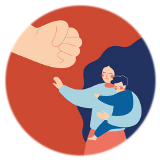Lifting the Veil of Silence on Family Violence
Often hidden from view, abuse within households is an issue that bears more attention. Ms Kristine Lam (Arts and Social Sciences ’12), Lead Social Worker at Project StART, Care Corner Singapore Ltd, looks at the characteristics of this phenomenon, and how the community can support victims.

I never thought this could happen to me,” shared Ms Y as she recounted the violent incidents. Ms Y and her husband, Mr X, have been married for almost a decade and the couple have a daughter. To outsiders, the family appeared perfectly put together. Mr X would often wait to drive Ms Y home after work, and occasionally ordered flowers and gifts to be sent to her office. No one knew what was going on behind closed doors until Ms Y applied for a Personal Protection Order for herself and her daughter. “When he made threats to kill me, I knew I should no longer try to convince myself that everything was going to be alright,” she revealed.
Most of us might find it hard to associate individuals who are successful in their careers with instances of family violence. However, no one is exempt from the possibility of experiencing such abuse. Victims and perpetrators who approach our agency come from all walks of life. Factors such as financial conditions, education level, social status, and even religious background do not exclude individuals from being a perpetrator or a victim of family violence.
It’s Not Part of the New Normal
“Each time he used violence on me, I would think to myself, ‘Was it me? Was there something else I could have said or done so that our marriage could be better, and the violence wouldn’t happen again?’” Ms Y shared about how she attempted time and time again to manage the situation on her own. Victims might think that such situations are simply a normal part of married life. Some victims even blame themselves and perceive that it is their inability to manage “marital differences” which causes the perpetrator to be so angry to the point that they respond with violence. Initially, Ms Y thought that if she could provide an extra dose of acceptance and unconditional love, her abuser would one day see her contribution to the relationship and things would be fine again. “I thought he was just stressed at work and the little things at home got to him, causing him to scream insults at me,” shared Ms Y about her bid to make sense of the emotional violence. While she felt insulted and hurt by what Mr X said to her, she reasoned to herself that things were still alright since there were no physical injuries. Also, the abuse did not happen frequently, and Mr X would either apologise or treat her nicely the next day.
An Escalating Pattern
Like many victims, Ms Y found herself lowering her expectations of Mr X in the relationship: from being a caring gentleman who would love and protect her, to feeling that she could continue accepting the relationship as long as things did not turn physical. Hurling vulgarities, threatening to leave the relationship, and insulting her and her family members became “acceptable” and were described as “ways of expressing anger”.
Family violence usually starts off with the perpetrator devaluing or disregarding the well-being of the other party. After violence occurs, the abuser tends to apologise and attempt a reconciliation, fearful that the victim might leave them or disclose the incident to others. From this point, there is a chance that the abuser will use violence again when conflicts arise, and the cycle will repeat in this fashion. And when left unchecked, the violence tends to increase in lethality, such as threats to kill, or physical injuries which could result in permanent disability or even death.
The Barriers to Exit
Given the very real danger of escalation, why then do victims choose to stay? For many of the victims I work with, it is commonly shared that stepping forward to seek help is a difficult decision to make. Unlike many other acts of violence, family violence is caused by a person whom the victim loves, trusts, and/or is dependent upon. Stepping out to protect themselves may cause some victims to feel that they are harming their loved ones. Other victims may feel that they are ‘washing dirty linen in public’ or bringing shame to their family. In addition — particularly for victims of psychological and emotional violence — there tends to be a concern about whether others would believe them, and thus they might not be willing to come forth about the incidence of violence. Then there are those who may have been systematically isolated by the perpetrator and have limited access to resources such as accommodation and finances, which increase the challenges these victims would face if they were to leave the relationship. When the fear and cost of leaving continue to be high, victims may prefer staying in the abusive relationship to stepping out to seek help.
PAINFUL TRUTHS

According to a 2019 survey by global market research agency Ipsos and non-profit organisation United Women Singapore, 30% of Singaporeans say they have suffered abuse at the hands of a loved one.
Source: The Straits Times, 10 December 2019
6 in 10 victims of physical violence suffer repeat victimisation.
Source: AWARE, Violence Against Women Fact Sheet, 2020
More than a ‘Couple’ iSsue
Family violence is, unfortunately, not limited to cases of spousal abuse. Mdm B, 50, had been suffering at the hands of her mother-in-law for five years. She was given very little food each day and was hit a few times each week. Neighbours filed multiple reports with the police but because Mdm B herself denied all incidents of violence, there was little the authorities could do. Our agency visited Mdm B monthly for about a year, sharing with her the possibility of regaining safety as well as the resources available to her if she consented to receiving help. Mdm B repeatedly rejected the offer for assistance, as her family threatened not to let her see her children again should she disclose the violence.
Over time, neighbours found it difficult to accept her decision to continue to stay with her family, especially when the physical abuse affected Mdm B’s eyesight and caused her nasal bridge to be broken. Despite that, they did not grow weary in supporting her. They continued to make police reports each time they heard Mdm B’s screams when she was beaten. Three years later, an extremely violent incident eventually led Mdm B to leave with the police to go to the hospital. When we spoke with her again, Mdm B shared that while she was in the ambulance, what kept replaying in her mind were the words of people who had cared for her – the social workers who told her that she did not deserve such abuse, the police officers who repeatedly promised her protection even though she is not a Singaporean, and neighbours who would knock on her door when they heard her screams. While she took some time to reach out, it was the persistence of the community that convinced her to receive help.
We Are In It Together
For Mdm B, it was the consistent community support which eventually led her to decide that she could leave the abusive relationship. Victims need to know that people believe their stories and society will not turn a blind eye to their suffering. While our society prohibits the act of violence by one person on another, most of us are unsure of what to do when it happens in our own families or those of friends. This is especially so if we are taught not to meddle in other people’s domestic affairs and that we may not know enough to pass judgement. Questions such as whether we may be deemed as ‘busybodies’, or have the right to interfere in another person’s family matters, or doubts about whether the person has an actual need for help, would likely run through our minds and cause us to hesitate about taking further steps.
I would advocate for society to view family violence as a societal issue and not just a domestic one. That way, each of us, as a member of society, would no longer feel inhibited when wanting to show care and support to victims. Doing our part can involve smaller efforts like knocking on our neighbours’ doors to check in on them when we hear loud noises, or providing a listening ear to our friends or family who reveal that they are experiencing family violence. While we may not know what can be done in their situation, checking in with victims and encouraging them to seek help can go a long way in providing them with the support that they need at that moment. Together, we can stop abusive relationships.

Ms Kristine Lam graduated from the National University of Singapore with a Bachelor of Arts, majoring in Social Work. She joined Care Corner Singapore Ltd in 2012 and decided to specialise in Family Protection work in 2013. In 2017, she was awarded the Promising Social Worker Award by President Halimah Yacob (Law ’78). Ms Lam is currently the Lead Social Worker at Care Corner Project StART, a family violence specialist centre in Singapore. Besides leading the team at Project StART, she also regularly conducts family violence training for social service practitioners.